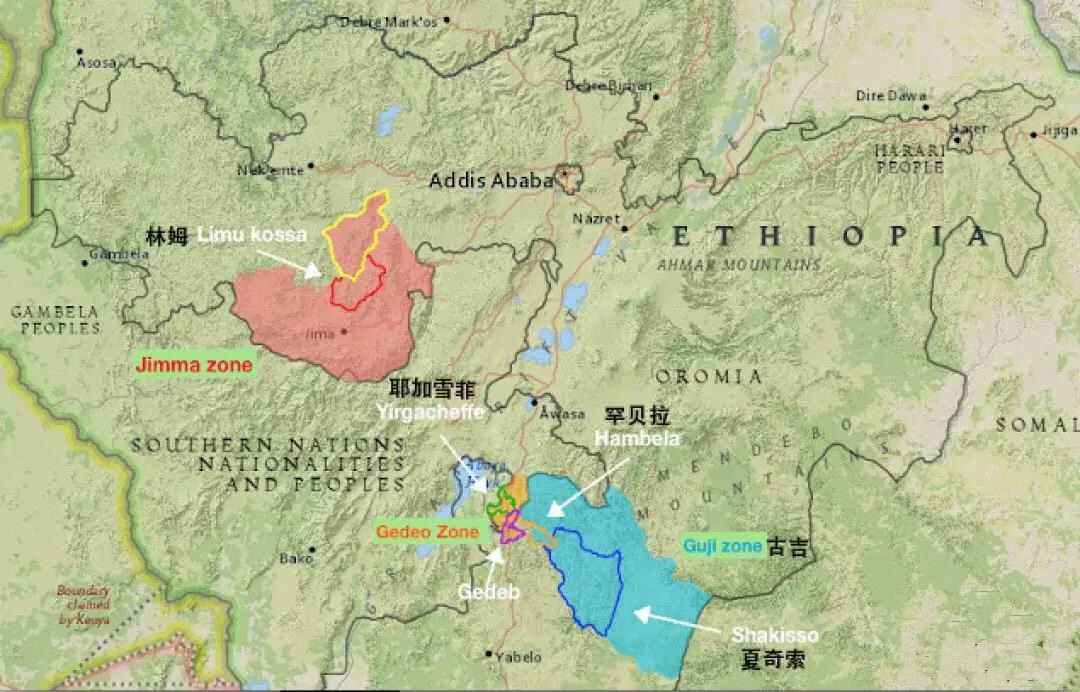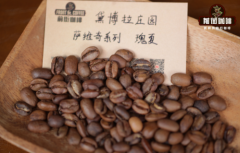Introduction of coffee producing countries in Africa-introduction of coffee producing areas in Ethiopia, Kenya and Yemen
Africa is the third largest coffee producer in the world, after South America and Asia. Ethiopia, Kenya and Yemen are the main coffee products in Africa. Ethiopia is the largest Arabica producer in Africa, followed by Kenya. Yemeni coffee production, which monopolized the global coffee market before the 18th century, is declining year by year and is about to disappear from the coffee map.
First of all, let's talk about Ethiopia, which is located in northeast Africa, bordering Djibouti and Somalia in the east, Sudan and the Republic of South Sudan in the west, Kenya in the south and Eritrea in the north.
Ethiopia has a history of 3000 years of civilization. The Aksum Kingdom was established around AD and was replaced by the Zag dynasty at the end of the 10th century. The Ethiopian Empire sprang up in the 13th century and split into several principalities at the beginning of the 19th century. In 1889, King Menilic II of Shao'a became emperor, unified the country, established the capital Addis Ababa, and established the territory of modern Ethiopia. In 1889, the Italian colonists signed the Treaty of Uciali with King Shao'a, and in 1890, the occupied area was named "Eritrea". In 1896, Ethiopia was defeated and forced to recognize Ethiopia's independence. In December 1950, the United Nations formed a federation of Eritrea as an autonomous body with Ethiopia. On September 12, 1974, a group of young officers staged a coup and abolished the monarchy. From April 23 to 25, 1993, Eritrea held a referendum under the supervision of the United Nations, and 99.8% of the people chose independence. The Ethiopian transitional government accepts the result of the referendum and recognizes the independence of Eritrea. The new constitution was adopted by the Constituent Assembly in December 1994. The first multi-party elections were held in May 1995. On 22 August, the Federal Democratic Republic of Ethiopia was established.
Ethiopia is a member of the African Union, whose headquarters are located in its capital. The economy is dominated by agriculture and animal husbandry, and the industrial foundation is weak.

Ethiopia changed the administrative division around 1995, and the greatest impact on the coffee area was that the original Sidamo Sidamo province was divided into the new Sidamo Sidama (the original minority), and most of it was classified into the Oromia Oromia state. And Yega Xuefei, which used to belong to Sidamo Province, is now classified as the new Gedeo of Gaidio District. Now there will be a mixture of Ethiopian coffee products in circulation with the names of new and old regions. Here, we take the new regional division as the benchmark, combined with the administrative region to understand Ethiopia's coffee growing map. Ethiopia's coffee cultivation is mainly in the western and southern region, and small farmers account for 90% of the total. Nearly 1.2 million of small farmers make a living by growing coffee, with an average planting area of less than 4 hectares, an average altitude of 1000-2300 meters, a planting density of 1000-1800 coffee trees per hectare, and a yield of nearly 600kg per hectare.
Coffee bean producing areas in Ethiopia can be divided into nine major producing areas. Here is a brief introduction to the most influential producing areas:
Yejia Xuefei (boutique producing area): 1800-2000 meters above sea level (pastoral coffee system)
Yega Xuefei is affiliated to the Sidamo producing area, which is separated separately because of its unique flavor. In addition to the small town of Yega Xuefei, it also includes three by-product areas around Wenago, Kochere, Gelena and Abaya. Therefore, Yirgacheffe A, Wenago A, Kochere An and Gelena/AbayaA will be more expensive than B of the same name in the new Yega Sheffield rating system.
Sidamo (boutique producing area): 1400-2200m above sea level (pastoral coffee system)
Sidamo coffee, which is delicately washed or sunburned, is usually sweet, and the strawberry flavor is loved by many coffee lovers and is worth as much as Yega Chuefei. The varieties of Sidamo and Yega Xuefei are similar, with medium-sized beans but also small seeds of dwarf plants, which farmers often sell separately. One of the most popular coffee beans in Sidamo is Sakuran, which has been a blockbuster since it was unveiled in Ethiopia's raw bean competition TOH in 2017, breaking Rosa's monopoly in the brewing competition and becoming the only coffee that can compete with it. Huakui comes from Humbera, a sub-production area of Guji, which, like Yega Xuefei, originally belonged to Sidamo and later became independent because of its outstanding flavor, but now when it comes to Guji, it is still generally default to Sidamo.
The Republic of Kenya (The Republic of Kenya) is located in eastern Africa, the equator runs through the central part, and the Great Rift Valley of East Africa runs through the north and south. It is bordered by Somalia to the east, Tanzania to the south, Uganda to the west, Ethiopia and South Sudan to the north, and the Indian Ocean to the southeast. The coastline is 536 km long. 18% of the land area is arable land, and the rest is mainly suitable for animal husbandry.
Coffee cultivation in Kenya
Located in eastern Africa, the equator runs through central China, and the Great Rift Valley stretches north and south. It is bordered by Somalia to the east, Tanzania to the south, Uganda to the west, Ethiopia and Sudan to the north, and the Indian Ocean to the southeast. There are many plateaus in the territory, with an average elevation of 1500 meters. The central peak of Kirinaga (Mount Kenya) is 5199 meters above sea level and the top of the mountain is covered with snow, making it the second highest peak in Africa.
Kenya is a tropical region, with two rainy seasons a year and two harvests, with 60% concentrated from October to December and 40% from June to August. Coffee is mainly grown in volcanic areas from the capital Narobi to the mountains of Kenya at an altitude of 1600-2100 meters. This height is suitable for the development of coffee bean flavor, because the mountain temperature is lower, the growth is slow, the aroma components of coffee beans have been fully developed, the sour taste is more obvious, and the texture is harder. This fertile moonbend-shaped coffee area is the main producer of Kenyan boutique beans.
Kenyan producing area
The main coffee producing areas in Kenya are six major producing areas, including: Thika, Kirinyaga, and the western side of Mount Kenya (Mt. Kenya West, Nyeri, Kiambu, Muranga. The harvest periods of the six major producing areas are all from October to December (the main production season) and from June to August (the by-product season).
Here we will talk about the main producing area of Sika, a small town in Nairobi, the capital of Kenya. There are many coffee fields around Nairobi, and Sika is an industrial town, but surrounded by agriculture and waterfalls. There are about 2000 farmers in Sika. The planting history of Kenyan Sika coffee can be traced back to the end of the 19th century. Coffee trees were introduced from neighboring Ethiopia in the north and improved by their own varieties. At present, the common varieties are Bourbon, Kents, SL34, SL28, Typica and Riuri 11. Now about 90% of the coffee varieties are SL34 and SL28. The new variety Batian published in 2007 has not been planted in large quantities. The flavor of the region has bright acidity, thick berry juice and honey sweetness.
Altitude: 1550mi 1750m
Variety: sl-28,sl-34

Yemen is located at the southwestern tip of the Arabian Peninsula, bordering Saudi Arabia and Oman, bordering the Red Sea, the Gulf of Aden and the Arabian Sea. Yemeni mocha coffee is the oldest coffee in the world, and Yemen is one of the first countries in the world to grow coffee. It is said that as early as 1561 AD, Zheng he brought back a lot of mocha coffee to pay tribute to the Ming emperor.
As early as more than 500 years ago, Yemen produced coffee in an ancient way. In the early 17th century, the first batch of Yemeni coffee sold to Europe was exported through the ancient port of Mocha, which surprised Europeans. The delicious coffee shipped from the port of Mocha was called "mocha coffee", which is the origin of the name "mocha coffee". Today, the old port of Mocha has long been abandoned because of sediment deposition (today's place name Al Makha). It has become a historic port with only white beach left, and it is exported to the northwestern port of Hodeida. However, people have long been accustomed to the name of Mocha, which is famous to the sky. Yemeni mocha is the originator of the world coffee trade. It plays an important role in promoting delicious coffee to Yemen all over the world. It is called "Arabica Coffee (Arabia)", which is the origin of the name "Arabica Origin".
Important Notice :
前街咖啡 FrontStreet Coffee has moved to new addredd:
FrontStreet Coffee Address: 315,Donghua East Road,GuangZhou
Tel:020 38364473
- Prev

How are the rosy coffee beans? Evaluation of solarization flavor of Rosa rosacea by special treatment.
Panama Rose Summer Coffee Bean Deborah Manor Savage anaerobic fermented Sun Bean introduction Panama's Rose Summer Coffee has always attracted everyone's attention. In the 2004 BOP contest, Rose Summer Coffee became very popular, while in the following years of raw bean competition, Rosa Coffee almost won the championship and created a champion manor. The rosy summer of Panama will show exquisite aromas of flowers, oranges,
- Next

Ethiopian Coffee Bean: COE22 Coffee Bean and Sun-Red Cherry Coffee Bean Flavor Description
What is the difference between Ethiopian coffee beans COE22 and sun-dried red cherries? From coffee bean history differences, Cup of Excellence short for COE, a fine coffee rating system. The origins of the Cup of Excellence system: The reason why producers have incentives to grow high-quality coffee is not just that I want to grow delicious coffee! This kind of self-awareness, but also have high profits
Related
- Beginners will see the "Coffee pull flower" guide!
- What is the difference between ice blog purified milk and ordinary milk coffee?
- Why is the Philippines the largest producer of crops in Liberia?
- For coffee extraction, should the fine powder be retained?
- How does extracted espresso fill pressed powder? How much strength does it take to press the powder?
- How to make jasmine cold extract coffee? Is the jasmine + latte good?
- Will this little toy really make the coffee taste better? How does Lily Drip affect coffee extraction?
- Will the action of slapping the filter cup also affect coffee extraction?
- What's the difference between powder-to-water ratio and powder-to-liquid ratio?
- What is the Ethiopian local species? What does it have to do with Heirloom native species?

